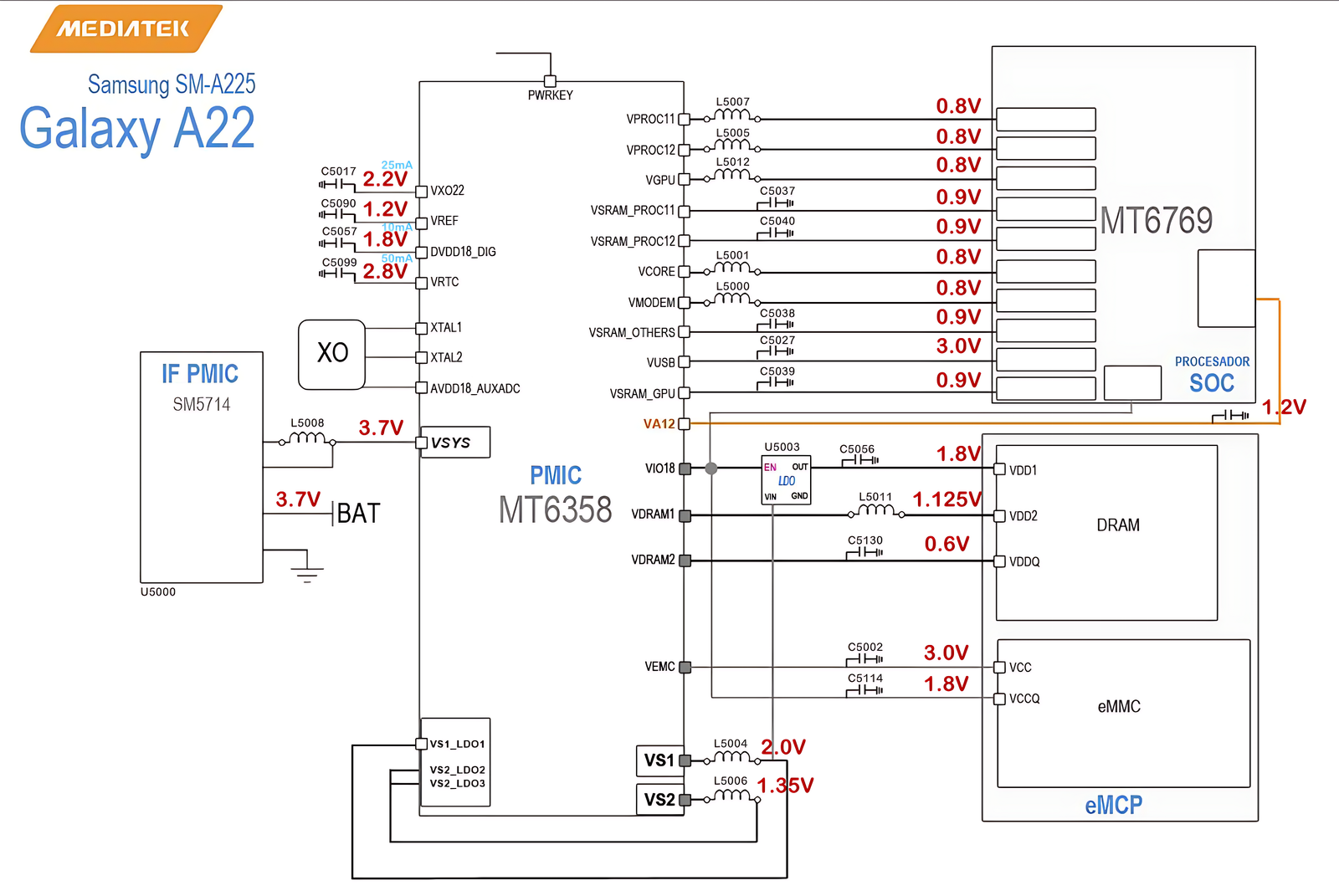Voltage Distribution in Samsung Galaxy A22 (SM-A225) MT6358 PMIC
Introduction
The Samsung Galaxy A22 (SM-A225) relies on the MT6358 Power Management Integrated Circuit (PMIC) for efficient power distribution across its components. The PMIC ensures that each part of the device, from the processor to memory and sensors, receives the correct voltage required for optimal performance. In this post, we will discuss how the MT6358 PMIC manages power in the Galaxy A22, detailing the various voltage rails and their specific applications.

Voltage Rails in the Galaxy A22
The MT6358 PMIC is responsible for generating and distributing a range of voltage levels. These voltage levels are used to power various components, such as the processor (SOC), memory (DRAM), and eMMC storage. Below is a list of key voltage rails in the Galaxy A22 and their respective uses:
- 3.7V (VSYS): The primary voltage rail coming directly from the battery, used to power the PMIC and other core systems of the device.
- 2.8V: This voltage powers low-power components and some sensors in the device.
- 2.0V: Used to power specific peripherals and sub-circuits that require this voltage for efficient operation.
- 1.8V: Provides power to the processor's core and other important components requiring stable and reliable power.
- 1.35V (VS2): Powers high-performance modules, ensuring that power is supplied efficiently to sections like the GPU or other performance-sensitive components.
- 1.2V: The processor (SOC) operates on this voltage, ensuring that the device runs smoothly while handling multitasking and other intensive operations.
- 0.9V: Used for the GPU and other sections requiring low voltage, ensuring energy efficiency and low heat generation.
- 0.8V: Powers various low-power circuits and the SOC's core for minimal energy consumption.
- 0.6V: This is used for power-saving components, allowing the device to run with minimal energy consumption when idle or in low-power states.
- 1.125V (VDram): The DRAM modules receive this voltage to ensure fast memory access and efficient data transfer.
- 3.0V (eMMC): This voltage rail powers the eMMC storage, ensuring reliable reading and writing of data for the device's storage system.
How the MT6358 PMIC Works
The MT6358 PMIC is a highly integrated power management solution that uses a combination of Low Dropout Regulators (LDOs) and buck converters to convert the input voltage (3.7V from the battery) into the necessary outputs. Each voltage rail is regulated to ensure that it delivers a precise, stable voltage to its respective components.
Voltage Regulation Through LDOs and Buck Converters
The MT6358 uses LDOs and buck converters to efficiently regulate the voltage levels:
- 1.8V LDO (U5003): This LDO is used for powering the processor (SOC) and high-performance modules that need stable voltage for efficient processing.
- 0.8V LDO (U5000): This LDO provides power to low-power sections of the processor and GPU, ensuring that they operate with minimal energy consumption.
- 1.35V Buck Converter (VS2): This regulator is responsible for delivering stable power to high-performance sections like the GPU, maintaining consistent operation under load.
- 1.125V LDO (VDram): This LDO provides power to the DRAM, ensuring that memory access remains fast and efficient.
- 0.6V LDO: This LDO is used for very low-power components, ensuring that power consumption is minimized in low-demand scenarios.
- 3.0V for eMMC: The eMMC storage requires 3.0V to function correctly, and the PMIC ensures that this voltage is regulated for efficient read/write operations.
Voltage Distribution Across the Device
The PMIC distributes the regulated voltages throughout the device, ensuring that each component receives the correct voltage level. Some of the key components powered by the PMIC include:
- Processor (SOC): The SOC requires multiple voltage rails such as 1.8V, 1.2V, and 0.9V to handle the complex processing tasks that keep the device running efficiently.
- DRAM: The DRAM requires 1.125V to operate optimally, enabling quick access to memory and fast data transfer.
- eMMC Storage: The eMMC storage requires 3.0V for proper operation, allowing for smooth read/write operations.
- GPU: The GPU, which handles graphical rendering, is powered by 0.9V, providing it with the energy it needs to render graphics smoothly without consuming too much power.
- Sensors and Other Peripherals: Components such as sensors and auxiliary modules are powered by various voltages, including 2.8V, 1.8V, and 1.2V, depending on their specific requirements.
Why These Voltage Levels Are Important
Each voltage rail in the Galaxy A22 has been specifically chosen to meet the needs of individual components. Here’s why each voltage level is important:
- Processor (SOC): The SOC requires 1.8V and 1.2V to function properly, allowing the device to handle heavy processing tasks such as multitasking and gaming.
- Memory (DRAM): The 1.125V supply to DRAM ensures quick memory access, which is crucial for smooth operation and fast app loading times.
- Graphics (GPU): The GPU operates efficiently on 0.9V, balancing performance and power consumption to provide smooth graphics rendering without overheating the device.
- Energy Efficiency: The use of lower voltage levels, such as 0.6V and 0.8V, ensures that components consume less power, thus prolonging battery life.
Conclusion
The MT6358 PMIC plays a critical role in the Samsung Galaxy A22 by managing the distribution of power across various components of the device. By using a combination of LDOs and buck converters, the PMIC ensures that each section of the device receives the correct voltage, allowing for smooth operation, energy efficiency, and long-lasting performance. Understanding how power is distributed in the device helps in appreciating the complex design of modern smartphones and the critical role of power management in ensuring optimal functionality.
